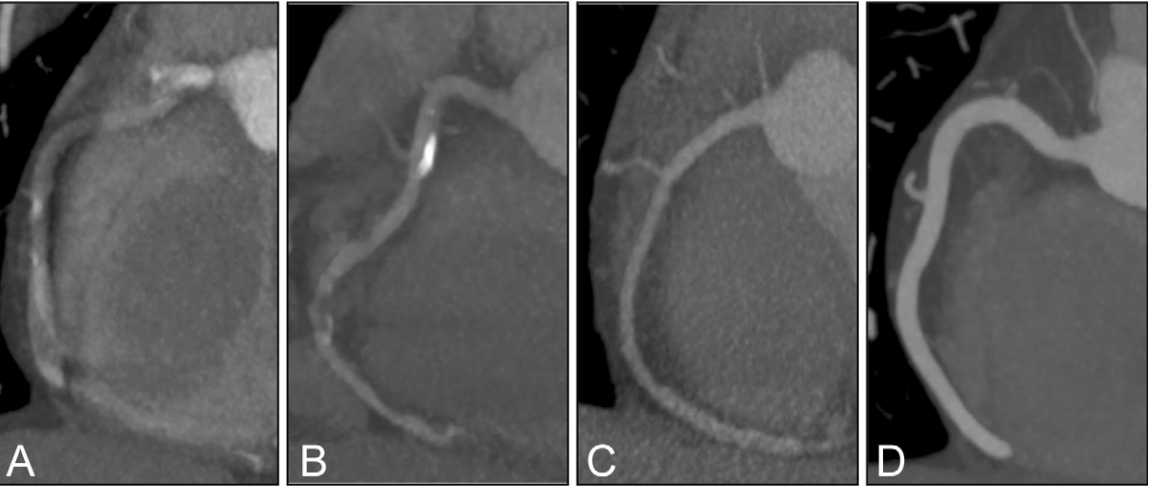Lower Heart Rate Improves CCTA Image Quality, Dose Exposure
Identification of optimal heart rate supports use of beta blockers when possible.
Having a lower heart rate can improve the image quality of a patient’s coronary CT angiography (CCTA), as well as lower the radiation dose used.
In a research letter published June 15 in Radiology, a multi-institutional, multi-national group of researchers demonstrated that, across a wide variety of CT scanners, patient with heart rates lower than 60 beats per minute enjoyed these benefits. The results, they said, support using beta blockers to help control heart rate for some individuals unless there are contraindications.
“The results from this international multi-vendor, real-world analysis confirm the notion that heart rate has significant influence on image quality in coronary CTA,” said the team led by Thomas J. Stocker, M.D., from Medizinische Klinik and Poliklinik I, Ludwig-Maximilians-Universität in Germany. “The results suggest that cardiologists and radiologists should aim for a lower patient heart rate to obtain the best image quality and simultaneously allow for lower radiation dose in coronary CTA imaging.”
Heart rate is a known independent indicator for CCTA image quality of radiation exposure, but given improvements to scanner equipment and protocols, it is unclear if there is an optimal heart rate for these studies. To figure out if one exists, Stocker’s team conducted a sub-analysis of the Prospective Multi-Center Registry on Radiation Dose Estimates of Cardiac CT Angiography in Daily Practice (PROTECTION).
For their study, between March 2017 and December 2017, they analyzed the first 50 percent of CCTAs from 57 sites worldwide, including 1,911 patients (43 percent women) with an average age of 59 and average heart rate of 60 beats-per-minute (BPM). Scans were conducted on equipment from Siemens Healthineers, GE Healthcare, Canon Medical, and Philips Healthcare.
The team grouped study participants into heart-rate cohorts based on 5-BPM intervals, such as 45-to-50. Two radiologists analyzed the scans, examining signal-to-noise ratio, contrast-to-noise ratio, and dose-length product. They categorized the image quality of the left main artery, left anterior descending artery, left circumflex artery, and right coronary artery in a four-point scale that ranged from non-diagnostic (1) to excellent (4). In addition, they assessed the effect heart rate reduction had on image quality and radiation exposure.
CT angiographs show representative grading of the image quality for the right coronary artery. A, Grade 1 (nondiagnostic); B, grade 2 (adequate); C, grade 3 (good); D, grade 4 (excellent).
Credit: RSNA

Overall, they identified a median signal-to-noise ratio of 14, median contrast-to-noise of 11, and median dose-length product of 170 mGy cm, as well as an average image quality score of 3.5. Patients with stable sinus rhythm had better image quality scores.
However, the team said, image quality scores were higher than 3.5 for patients with heart rates lower than 60 BPM. In fact, the image quality scores increased by 0.18 for every 10-BPM reduction. Median dose-length product dropped by 48 mGy cm for every 10-BPM decrease, as well.
Based on these findings, the team recommended beta blocker use with patients who have a heart rate higher than 75 BPM, and they cautiously recommended use for patients with heart rates between 60-and-75 BPM.
The results of this study add substantially to the existing body of knowledge around the role heart rate plays in image quality and dose exposure, said U. Joseph Schoepf, M.D., a radiology, medicine, and pediatrics professor, and Josua Decker, M.D., a post-doctoral cardiovascular imaging fellow, both from the Medical University of South Carolina. Not only is their work relevant to clinical practice, they said in an accompanying editorial, but it is based on outcomes from multiple scanner types in sites around the world that have their own CT protocols.
Knowing how to improve image quality and control radiation dose will become increasingly important, they said, because the number of CCTAs will increase as the population ages.
“The study by Stocker and colleagues has real-world results that show that even with our modern high-resolution CT scanners, heart rate significantly influences diagnostic quality and radiation dose of coronary CTA,” they said. “Given these results, the heart rate of every patient should be carefully evaluated prior to the examination.”
For more coverage based on industry expert insights and research, subscribe to the Diagnostic Imaging e-Newsletter here.
What is the Best Use of AI in CT Lung Cancer Screening?
April 18th 2025In comparison to radiologist assessment, the use of AI to pre-screen patients with low-dose CT lung cancer screening provided a 12 percent reduction in mean interpretation time with a slight increase in specificity and a slight decrease in the recall rate, according to new research.
The Reading Room: Racial and Ethnic Minorities, Cancer Screenings, and COVID-19
November 3rd 2020In this podcast episode, Dr. Shalom Kalnicki, from Montefiore and Albert Einstein College of Medicine, discusses the disparities minority patients face with cancer screenings and what can be done to increase access during the pandemic.
Can CT-Based AI Radiomics Enhance Prediction of Recurrence-Free Survival for Non-Metastatic ccRCC?
April 14th 2025In comparison to a model based on clinicopathological risk factors, a CT radiomics-based machine learning model offered greater than a 10 percent higher AUC for predicting five-year recurrence-free survival in patients with non-metastatic clear cell renal cell carcinoma (ccRCC).
Could Lymph Node Distribution Patterns on CT Improve Staging for Colon Cancer?
April 11th 2025For patients with microsatellite instability-high colon cancer, distribution-based clinical lymph node staging (dCN) with computed tomography (CT) offered nearly double the accuracy rate of clinical lymph node staging in a recent study.